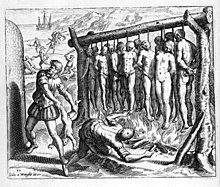Taíno genocide
| Taíno genocide | |
|---|---|
 A 16th-century illustration by Flemish Protestant Theodor de Bry for Bartolomé de las Casas' Brevisima relación de la destrucción de las Indias, depicting Spanish torture of Indigenous peoples during the conquest of Hispaniola. | |
| Location | West Indies |
| Date | 1493 - 1550 |
| Target | Taíno |
Attack type | Genocide, slavery |
| Deaths | Between 80% and 90% of the Taíno population died in first 30 years.[1][2] |
| Perpetrators | Spanish Empire |
| Motive | Colonialism Spanish imperialism |
| Part of a series on |
| Genocide of Indigenous peoples |
|---|
| Issues |
The Taíno genocide was committed against the
The Taíno people were the descendants of the
For several months after that event,
In thirty years, between 80% and 90% of the Taíno population died.[1][2] Because of the increased number of people (Spanish) on the island, there was a higher demand for food. Taíno cultivation was converted to Spanish methods. In hopes of frustrating the Spanish, some Taínos refused to plant or harvest their crops. The supply of food became so low in 1495 and 1496 that some 50,000 died from famine.[8] Historians have determined that the massive decline was due more to infectious disease outbreaks than any warfare or direct attacks.[9][10] By 1507, their numbers had shrunk to 60,000. Scholars believe that epidemic disease (smallpox, influenza, measles, and typhus) was an overwhelming cause of the population decline of the Indigenous people,[11] and also attributed a "large number of Taíno deaths...to the continuing bondage systems" that existed.[12][13] Academics, such as historian Andrés Reséndez of the University of California, Davis, assert that disease alone does not explain the destruction of Indigenous populations of Hispaniola. While the populations of Europe rebounded following the devastating population decline associated with the Black Death, there was no such rebound for the Indigenous populations of the Caribbean. He concludes that, even though the Spanish were aware of deadly diseases such as smallpox, there is no mention of them in the New World until 1519, meaning perhaps they did not spread as fast as initially believed, and that, unlike Europeans, the Indigenous populations were subjected to enslavement, exploitation, and forced labor in gold and silver mines on an enormous scale.[14] Reséndez says that "slavery has emerged as a major killer" of the Indigenous people of the Caribbean.[15] Anthropologist Jason Hickel estimates that the lethal forced labor in these mines killed a third of the Indigenous people there every six months.[16]
Subsequently, in the United States, Yale University classified the atrocities which the Spanish Empire committed against the Taíno as a «genocide» and it also included the Taíno genocide in its Genocide Studies Program.[4]
See also
- Taíno
- Jaragua massacre
- Colonialism and genocide
- Genocide of indigenous peoples
- Genocides in history
- Indigenous response to colonialism
- List of ethnic cleansing campaigns
- List of genocides
References
- ^ a b "La tragédie des Taïnos", in L'Histoire n°322, July–August 2007, p. 16.
- ^ a b Diaz Soler, Luis Manuel (1950). Historia De La Esclavitud Negra en Puerto Rico (Thesis). LSU Historical Dissertations and Theses. Retrieved 2021-01-12.
- ^ a b c d e Carolina Pichardo (October 12, 2022). "Anacaona, the Aboriginal chieftain who defied Christopher Columbus and was sentenced to a tragic death". BBC News Mundo.
- ^ a b c "Hispaniola - Genocide Studies Program". Yale University.
- ^ National Geographic. October 15, 2019.
- ^ Luis Méndez (October 12, 2022). "The Taínos: the indigenous people who became extinct in the Caribbean after the Spanish conquest". The News.
- CNN in Spanish. October 11, 2022.
- ISBN 9781113147608. Retrieved 21 July 2010.
- ISBN 9781113147608. Retrieved 21 July 2010.
- ISBN 978-0-521-55203-5. Archivedfrom the original on 2016-02-02. Retrieved 2016-01-05.
- ISBN 978-0-415-27816-4. Archivedfrom the original on 2016-02-02. Retrieved 2016-01-05.
- ^ Schimmer, Russell. "Puerto Rico". Genocide Studies Program. Yale University. Archived from the original on 2011-09-08. Retrieved 2011-12-04.
- ISBN 978-0-391-04206-3. Archivedfrom the original on 2016-02-02. Retrieved 2016-01-05.
- The Los Angeles Times. Archivedfrom the original on June 23, 2019. Retrieved June 22, 2019.
- ISBN 978-0547640983. Archivedfrom the original on 2019-10-14. Retrieved 2019-06-21.
- ISBN 978-1786090034.
